1998 HONDA ODYSSEY fog light
[x] Cancel search: fog lightPage 50 of 272

Instruments and Controls
This section gives information about
the controls and displays thatcontribute to the daily operation of
your Honda. All the essential
controls are within easy reach.
Control Locations............................ 50
Indicator Lights................................ 51
Gauges.............................................. 54
Tachometer.................................. 54
Trip Meter.................................... 54
Speedometer................................ 55
Odometer...................................... 55
Temperature Gauge.................... 55
Fuel Gauge................................... 55
Maintenance Required
Indicator.................................... 56
Controls Near the Steering
Wheel........................................ 57
Headlights.................................... 58
Daytime Running Lights............. 58
Instrument Panel Brightness..... 59
Turn Signals................................. 59
Windshield Wipers...................... 60
Windshield Washers................... 61
Rear Window Wiper and
Washer...................................... 61
Hazard Warning........................... 61
Rear Window Defogger.............. 62
Steering Wheel Adjustment....... 62
Steering Wheel Controls ................ 64
Cruise Control.............................. 64
Keys and Locks................................ 67
Keys............................................... 67
Immobilizer System..................... 68
Ignition Switch............................. 69
Power Door Locks....................... 70
Remote Transmitter.................... 71
Childproof Door Locks............... 72
Tailgate......................................... 72
Glove Box..................................... 73
Seats.................................................. 74
Passenger Seating....................... 74
Seat Adjustments......................... 74
Driver's Seat Power Height
Adjustment............................... 75
Armrests....................................... 76
Head Restraints........................... 76
Third Seat Access........................ 77
Removing the Second Seats
in the Six-Passenger Model.... 78
Folding the Second Seats
in the Seven-Passenger
Model.................................... 78
Reclining the Second Seat.......... 79
Folding the Third Seat
in All Models............................ 80
Power Windows............................... 82
Sunroof.............................................. 83
Mirrors.............................................. 84
Adjusting the Power Mirrors..... 84
Parking Brake.................................. 85
Digital Clock..................................... 86 Beverage Holder.............................. 86
Dashboard Compartment............... 88
Center Pocket.................................. 88
Vanity Mirror................................... 88
Cigarette Lighter............................. 89
Ashtrays............................................ 89 Interior Lights.................................. 90
Ceiling Lights............................... 90
Spotlights...................................... 90
Tailgate Light............................... 91 Courtesy Lights........................... 91
Instruments and ControlsProCarManuals.comMain Menu s t
Page 58 of 272
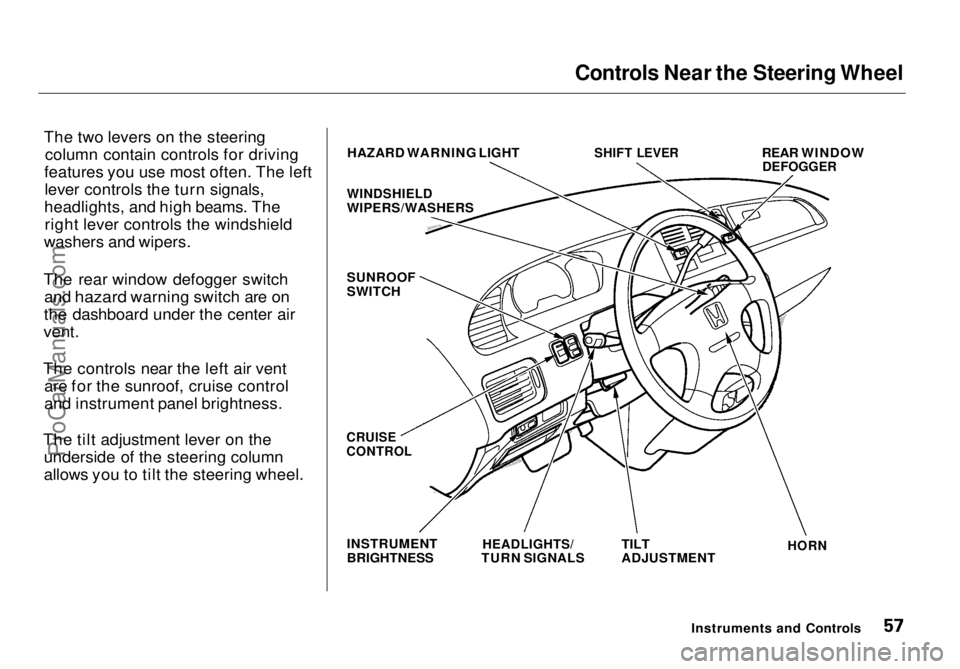
Controls Near the Steering Wheel
The two levers on the steering column contain controls for driving
features you use most often. The left lever controls the turn signals,
headlights, and high beams. The right lever controls the windshield
washers and wipers.
The rear window defogger switch and hazard warning switch are on
the dashboard
under the center air
vent.
The controls near the left air vent are for the sunroof, cruise control
and instrument panel brightness.
The tilt adjustment lever on the underside of the steering column
allows you to tilt the steering wheel. HAZARD WARNING LIGHT
WINDSHIELD
WIPERS/WASHERS
SUNROOF
SWITCH
SHIFT LEVER
REAR WINDOW
DEFOGGER
CRUISE
CONTROL
INSTRUMENT
BRIGHTNESS
HEADLIGHTS/
TURN SIGNALS
TILT
ADJUSTMENT
HORN
Instruments and ControlsProCarManuals.comMain Menu Table of Contents s t
Page 63 of 272
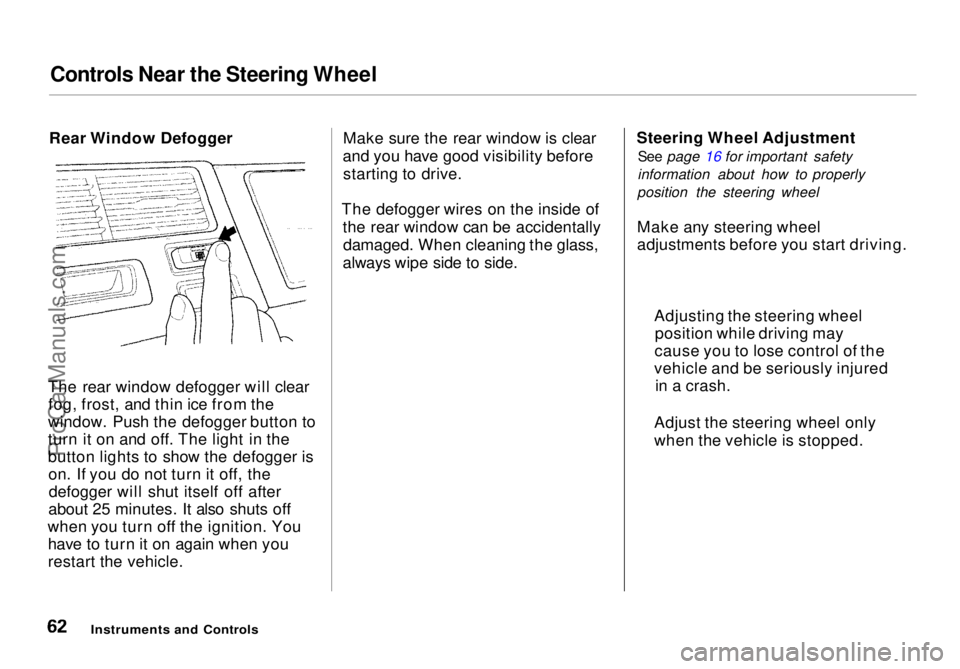
Controls Near the Steering Wheel
Rear Window Defogger
The rear window defogger will clear fog, frost, and thin ice from the
window. Push the defogger button to
turn it on and off. The light in the
button lights to show the defogger is on. If you do not turn it off, thedefogger will shut itself off after
about 25 minutes. It also shuts off
when you turn off the ignition. You have to turn it on again when you
restart the vehicle. Make sure the rear window is clear
and you have good visibility before starting to drive.
The defogger wires on the inside of the rear window can be accidentallydamaged. When cleaning the glass,
always wipe side to side. Steering Wheel Adjustment
See page 16 for important safety
information about how to properly
position the steering wheel
Make any steering wheel
adjustments before you start driving.
Instruments and Controls
Adjusting the steering wheel
position while driving may
cause you to lose control of the
vehicle and be seriously injured in a crash.
Adjust the steering wheel only
when the vehicle is stopped.ProCarManuals.comMain Menu Table of Contents s t
Page 150 of 272
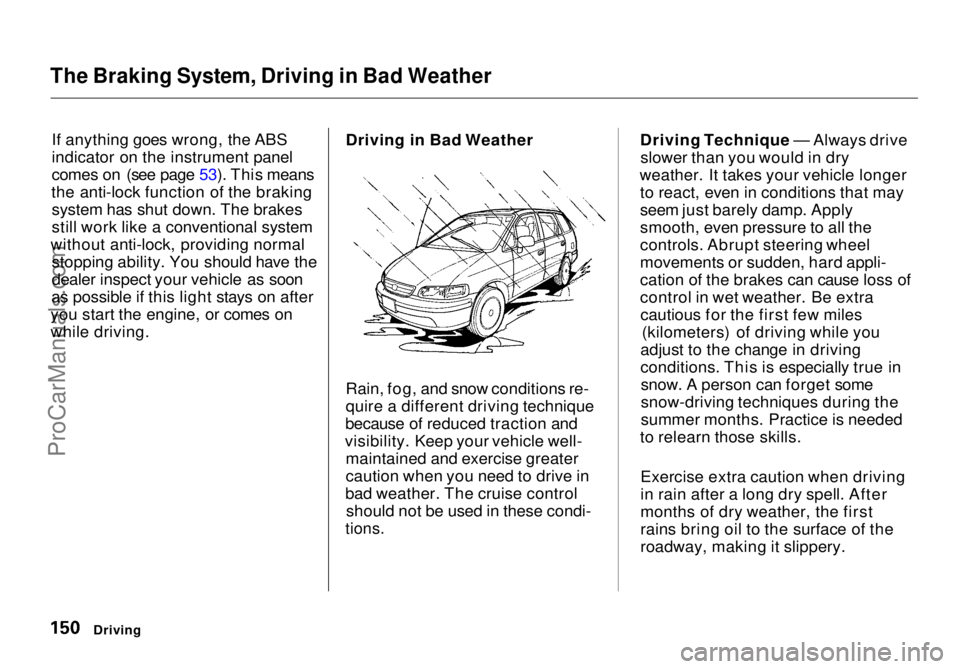
The Braking System, Driving in Bad Weather
If anything goes wrong, the ABS
indicator on the instrument panel
comes on (see page 53). This means
the anti-lock function of the braking system has shut down. The brakes
still work like a conventional system
without anti-lock, providing normal stopping ability. You should have the
dealer inspect your vehicle as soon
as possible if this light stays on after
you start the engine, or comes on
while driving. Driving in Bad Weather
Rain, fog, and snow conditions re-
quire a different driving technique
because of reduced traction and
visibility. Keep your vehicle well- maintained and exercise greater
caution when you need to drive in
bad weather. The cruise control should not be used in these condi-
tions.
Driving Technique — Always drive
slower than you would in dry
weather. It takes your vehicle longer to react, even in conditions that may
seem just barely damp. Apply
smooth, even pressure to all the
controls. Abrupt steering wheel
movements or sudden, hard appli-
cation of the brakes can cause loss of
control in wet weather. Be extracautious for the first few miles (kilometers) of driving while you
adjust to the change in driving
conditions. This is especially true in snow. A person can forget some
snow-driving techniques during the
summer months. Practice is needed
to relearn those skills.
Exercise extra caution when driving
in rain after a long dry spell. After
months of dry weather, the first
rains bring oil to the surface of the
roadway, making it slippery.
DrivingProCarManuals.comMain Menu Table of Contents s t
Page 151 of 272
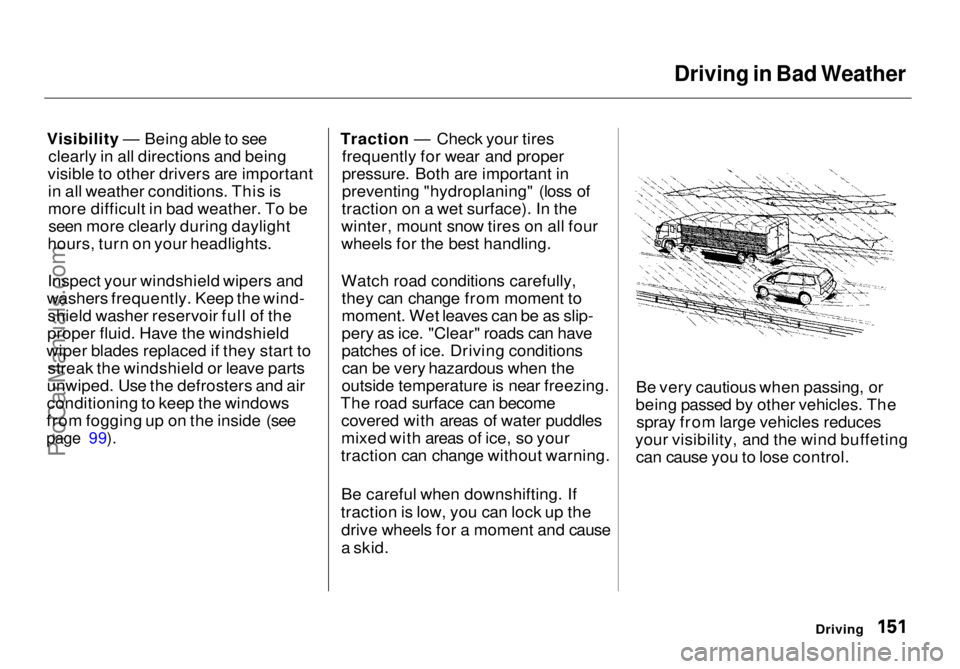
Driving in Bad Weather
Visibility — Being able to see clearly in all directions and being
visible to other drivers are important in all weather conditions. This is
more difficult in bad weather. To beseen more clearly during daylight
hours, turn on your headlights.
Inspect your windshield wipers and
washers frequently. Keep the wind- shield washer reservoir full of the
proper fluid. Have the windshield
wiper blades replaced if they start to streak the windshield or leave parts
unwiped. Use the defrosters and air
conditioning to keep the windows
from fogging up on the inside (see
page 99).
Traction — Check your tires
frequently for wear and proper
pressure. Both are important in
preventing "hydroplaning" (loss of
traction on a wet surface). In the
winter, mount snow tires on all four
wheels for the best handling.
Watch road conditions carefully, they can change from moment to
moment. Wet leaves can be as slip-
pery as ice. "Clear" roads can have
patches of ice. Driving conditionscan be very hazardous when the
outside temperature is near freezing.
The road surface can become covered with areas of water puddles
mixed with areas of ice, so your
traction can change without warning.
Be careful when downshifting. If
traction is low, you can lock up the drive wheels for a moment and cause
a skid. Be very cautious when passing, or
being passed by other vehicles. The spray from large vehicles reduces
your visibility, and the wind buffeting can cause you to lose control.
DrivingProCarManuals.comMain Menu Table of Contents s t
Page 265 of 272
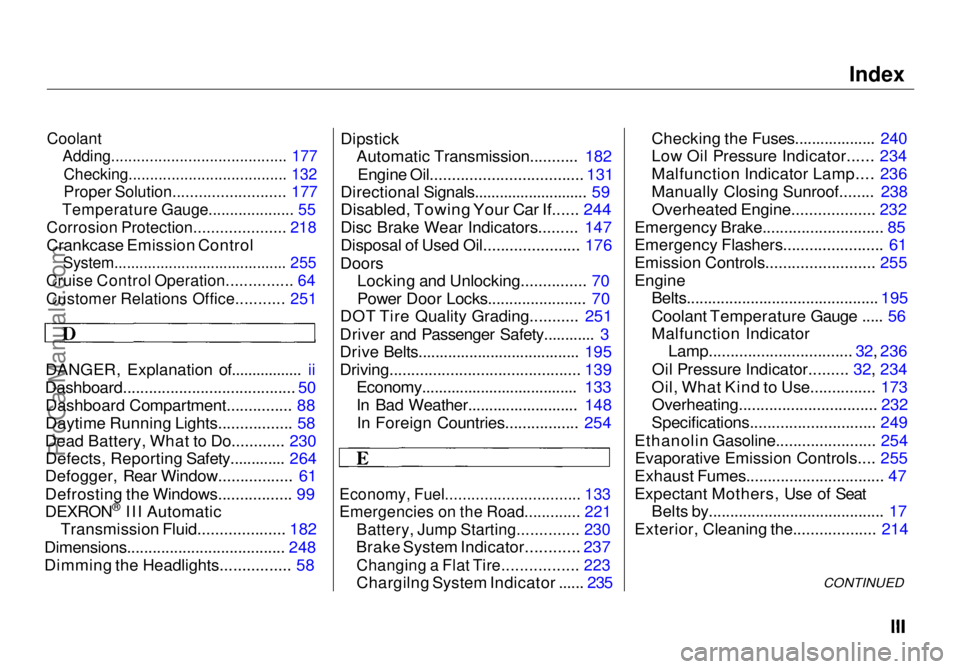
Index
Coolant
Adding......................................... 177
Checking..................................... 132
Proper Solution.......................... 177
Temperature Gauge.................... 55
Corrosion Protection..................... 218
Crankcase Emission Control
System......................................... 255
Cruise Control Operation............... 64
Customer Relations Office........... 251
DANGER, Explanation of................. ii
Dashboard........................................ 50 Dashboard Compartment............... 88
Daytime Running Lights................. 58
Dead Battery, What to Do............ 230 Defects, Reporting Safety............. 264
Defogger, Rear Window................. 61
Defrosting the Windows................. 99
DEXRON ®
III Automatic
Transmission Fluid.................... 182
Dimensions..................................... 248
Dimming the Headlights................ 58 Dipstick
Automatic Transmission........... 182
Engine Oil................................... 131
Directional Signals........................... 59
Disabled, Towing Your Car If...... 244
Disc Brake Wear Indicators......... 147
Disposal of Used Oil...................... 176
Doors Locking and Unlocking............... 70
Power Door Locks....................... 70
DOT Tire Quality Grading........... 251
Driver and Passenger Safety............ 3
Drive Belts...................................... 195
Driving............................................ 139 Economy..................................... 133
In Bad Weather.......................... 148
In Foreign Countries................. 254
Economy, Fuel............................... 133
Emergencies on the Road............. 221
Battery, Jump Starting.............. 230
Brake System Indicator............ 237
Changing a Flat Tire................. 223
Chargilng System Indicator ...... 235 Checking the Fuses................... 240
Low Oil Pressure Indicator...... 234
Malfunction Indicator Lamp.... 236
Manually Closing Sunroof........ 238
Overheated Engine................... 232
Emergency Brake............................ 85
Emergency Flashers....................... 61
Emission Controls......................... 255
Engine Belts............................................. 195
Coolant Temperature Gauge ..... 56
Malfunction IndicatorLamp................................. 32, 236
Oil Pressure Indicator......... 32, 234
Oil, What Kind to Use............... 173 Overheating................................ 232
Specifications............................. 249
Ethanolin Gasoline....................... 254 Evaporative Emission Controls.... 255
Exhaust Fumes................................ 47
Expectant Mothers, Use of Seat Belts by......................................... 17
Exterior, Cleaning the................... 214
CONTINUEDProCarManuals.comMain Menu s t
Page 268 of 272

Index
Octane Requirement, Gasoline.... 128
Odometer.......................................... 55
Odometer, Trip................................ 54
Oil Change, How to ......................... 175
Change, When to....................... 164
Checking Engine....................... 131
Pressure Indicator............... 52, 234
Selecting Proper Viscosity
Chart....................................... 174
ON (Ignition Key Position)............ 70
Opening the Hood......................... 130
Operation in Foreign Countries... 254
Outside Mirrors............................... 84
Overheating, Engine..................... 232
Owner Maintenance Checks........ 171
Panel Brightness Control............... 59
Park Gear Position......................... 143
Parking............................................ 146
Parking Brake.................................. 85
Parking Lights.................................. 58
Parking Over Things that Burn... 257
PGM-FI System.............................. 256
Polishing and Waxing................... 215
Power
Door Locks................................... 70
Mirrors.......................................... 84
Steering....................................... 184
Windows....................................... 82
Pre-Drive Safety Checklist............... 9
Pregnancy, Using Seat Belts.......... 17
Protecting Adults............................. 10
Additional Safety Precautions.... 17
Advice for Pregnant Women...... 17
Protecting Children......................... 19 Protecting Infants........................ 27
Protecting Larger Children........ 35
Protecting Small Children.......... 31
Using Child Seats withTethers...................................... 38
Radiator Overheating.................... 232
Radio/Cassette Sound System .... 103
Rear A/C Unit................................ 102
Rear End Towing........................... 244
Rear Lights, Bulb Replacement... 208
Rear View Mirror............................. 84
Rear Window Defogger.................. 62
Rear Window Wiper and Washer.. 61
Reclining the Seat Backs................ 75
Reclining the Second Seats............ 79 Reminder Lights.............................. 51
Remote Transmitter........................ 71 Removing the Second Seats........... 78
Replacement Information Air Cleaner Element.................. 185
Coolant........................................ 179
Engine Oil and Filter................. 175
Fuses........................................... 240
Light Bulbs................................. 206
Schedule..................................... 162
Spark Plugs................................. 187
Timing Belt................................. 195
Tires............................................ 199
Wiper Blades.............................. 191
Replacing Seat Belts After a Crash............................................. 43
Reserve Tank, Coolant.................. 132 Restraint, Child................................ 19
Reverse Gear Position................... 143
Rotation, Tire................................. 199ProCarManuals.comMain Menu s t